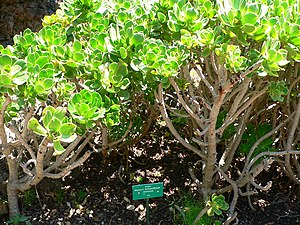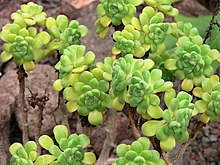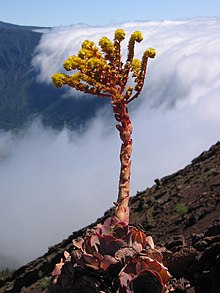Aeonium
| Aeonium | ||||||||||||
|---|---|---|---|---|---|---|---|---|---|---|---|---|

|
||||||||||||
| Systematics | ||||||||||||
|
||||||||||||
| Scientific name | ||||||||||||
| Aeonium | ||||||||||||
| Webb & Berthel. |
Aeonium is a genus of plants from the family of thick leaf plants (Crassulaceae). The botanical name is derived from the Greek word "αίώνιος" ( aionios ) for eternal, persistent.
description
Vegetative characteristics
The species of the genus Aeonium are biennial or usually perennial plants that are densely or slightly branched or have single shoots. Sometimes they grow as monocarpic subshrubs or single or cushion-forming, almost stemless rosette plants . Their roots are fibrous. The shoots are often ascending, sometimes form groups or are twisted. They are bald or downy - with Aeonium smithii they are densely hairy. The shoots are smooth or have a net-like pattern. There are often clear scars on the leaves. The leaf rosettes are rather flat with tightly pressed or upright inner leaves, or rather cup-shaped, often somewhat spherical and tightly closed during the dry season . The simple leaves with a broad base are fleshy to distinctly succulent and arranged in a spiral. Your leaf blade is often obovate or obovate-spatulate, sometimes ovate, elliptical or trowel-shaped. It is pointed towards the tip, tapered-pointed or rounded, tail or blunt. The base of the leaf blade is wedge-shaped or rarely significantly narrowed. The green or yellowish green, often pink or reddish variegated leaves are glabrous, almost glabrous or downy-haired. Occasionally they are bluish or sticky and sometimes shiny. On the edge of the leaf there are often clear, more or less straight or forward curved, teardrop or cone-shaped, single-celled hairs .
Inflorescences and flowers
The inflorescence is terminal, only in Aeonium smithii it appears from basal rosette axils. It is often hemispherical, ovoid, or conical. The distinct inflorescence stalk is often densely leafed. The flowers are 7 to 12 count (rarely 6 to 16 count) or 18 to 32 count. They have a diameter of 12 to 25 millimeters and stand on bare, slightly to clearly downy-haired 1 to 16 millimeter long flower stalks . The fleshy sepals are fused together at their base. They are bald or downy-haired. The petals that have not grown together are spread out or slightly bent back. They are often lanceolate or obscure, sometimes obovate and usually pointed or acuminate. The petals are pale to deep yellow or whitish and then often differently reddish in variety. There are twice as many stamens as there are petals. The free stamens are thread-like, glabrous or tomentose. The cylindrical anthers are colored differently yellow. The square or oblong, wedge-shaped nectar flakes are 0.5 to 1.5 millimeters long and 0.3 to 1.2 millimeters wide. Occasionally they are missing. There are as many carpels as there are petals. Sometimes they are clearly sunk into the receptacle . The carpels are bald or often covered with some glandular hair.
Fruits and seeds
The follicles contain warty or mostly ribbed, brownish seeds .
distribution
The Aeonium species are mainly endemic to the Canary Islands . Two species come from Madeira ( Aeonium glandulosum and Aeonium glutinosum ), one occurs in the Cape Verde Islands ( Aeonium gorgoneum ), another is native to southwest Morocco ( Aeonium korneliuslemsii ) and finally two species ( Aeonium leucoblepharum and Aeonium stuessyipharum ) East Africa (e.g. Semien Mountains / Ethiopia ).
Systematics







The first description of the genus Aeonium by Philip Barker Webb and Sabin Berthelot was published in 1840. Within the family of Crassulaceae , the genus belongs aeonium to the subfamily of the Semper Vivo ideae , where it is of the Tribe Aeonieae assigned. Synonyms are Greenovia Webb & Berthel. (1840), Aldasorea Hort. ex Haage & Schmidt (1930) and Megalonium (A.Berger) G.Kunkel (1980).
According to Reto Nyffeler , the genus Aeonium includes the following species, which are divided into 5 sections:
- Section Aeonium
-
Aeonium arboreum (L.) Webb & Berthel.
- Aeonium arboreum var. Arboreum
- Aeonium arboreum var. Holochrysum H.Y.Liu
- Aeonium arboreum var. Rubrolineatum (Svent.) HYLiu
- Aeonium balsamiferum Webb & Berthel.
- Aeonium gorgoneum J.A.Schmidt
- Aeonium korneliuslemsii H.Y.Liu
- Aeonium leucoblepharum Webb ex A.Rich.
- Aeonium stuessyi H.Y.Liu
- Aeonium undulatum Webb & Berthel.
-
Aeonium arboreum (L.) Webb & Berthel.
- Section Chrysocome Webb
- Aeonium goochiae Webb & Berthel.
-
Aeonium lindleyi Webb & Berthel.
- Aeonium lindleyi var. Lindleyi
- Aeonium lindleyi var. Viscatum (Bolle) HYLiu
- Aeonium saundersii Bolle
- Aeonium sedifolium (Webb ex Bolle) Pit. & Proust
- Aeonium simsii (Sweet) Stearn
- Aeonium smithii (Sims) Webb & Berthel.
- Aeonium spathulatum (Hornem.) Praeger
- Section Greenovia (Webb & Berthel.) T.Mes
- Aeonium aizoon (Bolle) T.Mes
- Aeonium aureum (C.Sm. ex Hornem.) T.Mes
- Aeonium diplocyclum (Webb ex Bolle) T.Mes
- Aeonium dodrantale (Willd.) T.Mes
- Section Leuconium A. Berger
- Aeonium appendiculatum Bañares
- Aeonium castello-paivae Bolle
- Aeonium ciliatum Webb & Berthel.
- Aeonium davidbramwellii H.Y.Liu
- Aeonium decorum Webb ex Bolle
- Aeonium gomerense (Praeger) Praeger
- Aeonium haworthii Salm-Dyck ex Webb & Berthel.
- Aeonium hierrense (RPMurray) Pit. & Proust
- Aeonium lancerottense (Praeger) Praeger
- Aeonium nobile (Praeger) Praeger
- Aeonium percarneum (RPMurray) Pit. & Proust
- Aeonium urbicum (C.Sm. ex Hornem.) Webb & Berthel.
- Aeonium valverdense (Praeger) Praeger
- Section Patinaria (Lowe) A. Berger
-
Aeonium canariense (L.) Webb & Berthel.
- Aeonium canariense var. Canariense
- Aeonium canariense var. Palmense (Webb ex Christ) HYLiu
- Aeonium canariense var. Subplanum (Praeger) HYLiu
- Aeonium canariense var. Virgineum (Webb ex Christ) HYLiu
- Aeonium cuneatum Webb & Berthel.
- Aeonium glandulosum (Aiton) Webb & Berthel.
- Aeonium glutinosum (Aiton) Webb & Berthel.
- Aeonium tabuliforme (Haw.) Webb & Berthel.
-
Aeonium canariense (L.) Webb & Berthel.
proof
literature
- R. Nyffeler: Aeonium . In: Urs Eggli (Ed.): Succulents Lexicon Volume 4 Crassulaceae (thick-leaf plants) . Eugen Ulmer Verlag, Stuttgart 2003, pp. 11-20 ISBN 3-8001-3998-7
Individual evidence
- ↑ a b c Reto Nyffeler: Aeonium . In: Urs Eggli (Hrsg.): Succulent lexicon. Crassulaceae (thick leaf family) . Eugen Ulmer, Stuttgart 2003, ISBN 3-8001-3998-7 , pp. 12 .
- ↑ Philip Barker Webb, Sabin Berthelot: Histoire naturelle des îles Canaries . Volume 3, Part 2, Section 1, 1840, pp. 184-198, plates 28-35 ( online ).
- ^ R. Nyffeler: Aeonium . In: Urs Eggli: Succulents Lexicon Volume 4. Crassulaceae (thick-leaf plants) . 2003, pp. 11-20
- ^ Corrected section membership, misprint in R. Nyffeler: Aeonium . In: Urs Eggli: Succulents Lexicon Volume 4. Crassulaceae (thick-leaf plants) . 2003, p. 17
further reading
- Tove H. Jorgensen, Jane Frydenberg: Diversification in insular plants: inferring the phylogenetic relationship in Aeonium (Crassulaceae) using ITS sequences of nuclear ribosomal DNA . In: Nordic Journal of Botany . Volume 19, No. 5, December 1999, pp. 613-621 ( doi : 10.1111 / j.1756-1051.1999.tb01150.x ).
- Tove H. Jorgensen, Jens M. Olesen: Growth rules based on the modularity of the Canarian Aeonium (Crassulaceae) and their phylogenetic value . In: Botanical Journal of the Linnean Society . Volume 132, 2000, pp. 223-240 ( doi : 10.1006 / bojl.1999.0294 , PDF online ).
- Ho-Yih Liu: Systematics of Aeonium (Crassulaceae) . Special Publication Number 3, National Museum of Natural Science, Taichung, Taiwan 1989
- HM Mes, HT Hart: The evolution of growth-forms in the Macaronesian genus Aeonium (Crassulaceae) inferred from chloroplast DNA RFLPs and morphology . In: Molecular Ecology . Volume 5, No. 3, June 1996, pp. 351-363 ( doi : 10.1111 / j.1365-294X.1996.tb00326.x ).
- Mark E. Mort, Douglas E. Soltis, Pamela S. Soltis, Javier Francisco-Ortega, Arnoldo Santos-Guerra: Phylogenetics and Evolution of the Macaronesian Clade of Crassulaceae Inferred from Nuclear and Chloroplast Sequence Data . In: Systematic Botany Band. 27, number 2, 2002, pp. 271-288 ( JSTOR 3093871 ).
- Mark E. Mort, Douglas E. Solits, Pamela S. Soltis, Arnoldo Santos-Guerra, Javier Francisco-Ortega: Physiological Evolution and Association between Physiology and Growth Form in Aeonium (Crassulaceae) . In: Taxon . Volume 56, Number 2, 2007, pp. 453-464 ( JSTOR 25065800 ).
- Giuseppe Tavormina, Saverio Tavormina: Sezione Greenovia. Opinioni attuali sulla classificazione della sezione Greenovia del genere Aeonium e ibridi naturali . In: Piante Grasse Volume 26, No. 2, 2006, pp. 46-51 ( online , Italian).